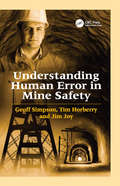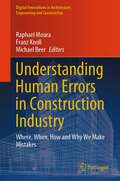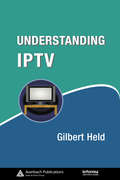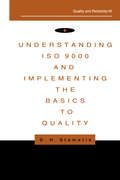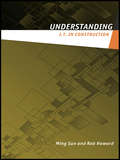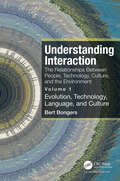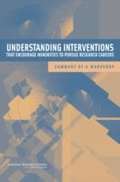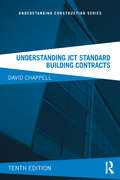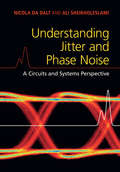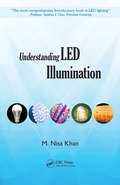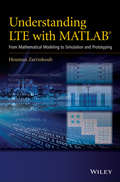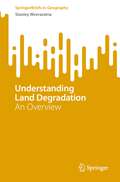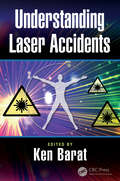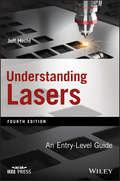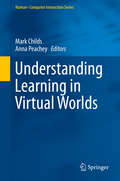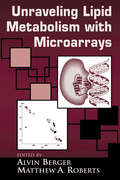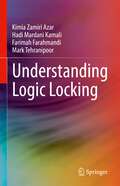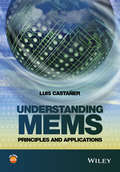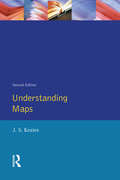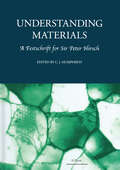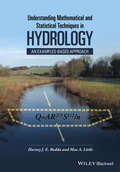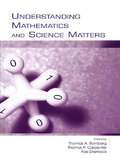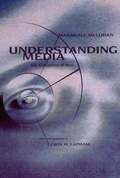- Table View
- List View
Understanding Human Error in Mine Safety
by Tim Horberry Geoff SimpsonThe consideration of human factors issues is vital to the mining industry. As in other safety-critical domains, human performance problems constitute a significant threat to system safety, making the study of human factors an important field for improving safety in mining operations. The primary purpose of this book is to provide the reader with a much-needed overview of human factors within the mining industry, in particular to understand the role of human error in mine safety, explaining contemporary risk management and safety systems approaches. The approach taken is multidisciplinary and holistic, based on a model of the systems of work in the mining industry domain. The ingredients in this model include individual operators, groups/teams, technology/equipment, work organisation and the physical environment. Throughout the book, topics such as human error and safety management are covered through the use of real examples and case studies, allowing the reader to see the practical significance of the material presented while making the text rigorous, useful and enjoyable. Understanding Human Error in Mine Safety is written for professionals in the field, researchers and students of mining engineering, safety or human factors.
Understanding Human Errors in Construction Industry: Where, When, How and Why We Make Mistakes (Digital Innovations in Architecture, Engineering and Construction)
by Michael Beer Raphael Moura Franz KnollThis book provides an analysis of the origin and effect of human errors in engineering. Using cases from everyday construction and large-scale accidents, the circumstances associated with the creation of errors are illustrated, along with strategies for their prevention, with the goal to eventually minimize cost overruns, delays, and accidents. The book features a discussion of the circumstances related to error proneness, the review of some sixty mishaps or near misses from real-life construction, the systematic analysis of 238 large-scale accidents in engineering systems, the perspective of psychology on the origin of faulty human performance, and a review of the relation of management to error proneness.
Understanding IPTV (Informa Telecoms & Media)
by Gilbert HeldDriven by a combination of technological improvements and commercial pressure, interest in IPTV services has increasingly grown. IPTV refers to the use of the Internet protocol required for delivery of television content. IPTV represents an emerging technology that could change the manner in which homes receive entertainment, personal computers ope
Understanding ISO 9000 and Implementing the Basics to Quality (Quality And Reliability Ser. #45)
by D.H. StamatisThis work examines the evolution and rationale of the ISO 9000 series of standards, their structure, interpretation and relationship to other quality systems. Theory and applications are provided, and the author explains how to put the standards into place and achieve quality. Specific methods and tools for the implementation of the ISO standards that lead to certification and certification maintenance are supplied.
Understanding IT in Construction
by Ming Sun Rob HowardIn recent years, Information Technology (IT) has been transforming business practice in many sectors resulting in efficiency gains and improved services for the client. The construction industry lags behind other manufacturing and service industries in adopting the new technology. To promote the wider use of IT in construction, it is essential to equip practitioners and graduates of construction related disciplines with knowledge of existing construction IT applications. This book provides an overview of a broad range of IT applications currently available for all stages throughout the life cycle of a building project, from essential office and information management through to computer-aided design (CAD), cost estimating, project planning and scheduling, and facilities management and building maintenance. It is an invaluable and handy reference for construction professionals and clients, as well as being a clear and comprehensive text for students studying construction, building or architectural courses.
Understanding Interaction: Volume 1: Evolution, Technology, Language and Culture
by Bert BongersUnderstanding Interaction explores the interaction between people and technology in the broader context of the relations between the human-made and the natural environments. It is not just about digital technologies – our computers, smartphones, the Internet – but all our technologies, such as mechanical, electrical, and electronic. Our ancestors started creating mechanical tools and shaping their environments millions of years ago, developing cultures and languages, which in turn influenced our evolution. Volume 1 looks into this deep history, starting from the tool-creating period (the longest and most influential on our physical and mental capacities) to the settlement period (agriculture, domestication, villages and cities, written language), the industrial period (science, engineering, reformation, and renaissance), and finally the communication period (mass media, digital technologies, and global networks). Volume 2 looks into humans in interaction – our physiology, anatomy, neurology, psychology, how we experience and influence the world, and how we (think we) think. From this transdisciplinary understanding, design approaches and frameworks are presented to potentially guide future developments and innovations. The aim of the book is to be a guide and inspiration for designers, artists, engineers, psychologists, media producers, social scientists, etc., and, as such, be useful for both novices and more experienced practitioners. Image Credit: Still of interactive video pattern created with a range of motion sensors in the Facets kaleidoscopic algorithm (based underwater footage of seaweed movement) by the author on 4 February 2010, for a lecture at Hyperbody at the Faculty of Architecture, TU Delft, NL.
Understanding Interventions That Encourage Minorities To Pursue Research Careers: Summary Of A Workshop
by National Research Council of the National AcademiesMinority groups are severely underrepresented in the scientific workforce. To encourage minorities to pursue careers in research, a variety of "intervention programs" have been created at the pre-college, college, and graduate school levels. While there is a belief that these programs often achieve their goals, there is relatively little understanding of the factors that contribute to that success. The Division of Minority Opportunities in Research (MORE) at the National Institute of General Medical Sciences of the National Institutes of Health has established a grant program to support research to better understand the factors that contribute to the success of intervention programs. The MORE Division asked the National Academies to organize a workshop focusing on issues addressed by the grant program. This workshop summary presents examples of previous research on intervention programs, describes ways to formulate effective research questions and conduct research to identify the key elements that lead to successful intervention programs, and outlines ways to foster a community of researchers in this area.
Understanding Iran
by Frederic Wehrey Jerrold D. Green Charles Jr. WolfA compact, user-friendly handbook for U.S. policymakers interested in understanding the Islamic Republic of Iran. It synthesizes existing analyses on Iran and draws from non-American experts with a different interpretive lens for viewing the seemingly opaque Iranian system. It provides short analytic observations about the processes, institutions, networks, and actors that define Iran's politics, strategy, economic policy, and diplomacy.
Understanding JCT Standard Building Contracts
by David ChappellThis ninth edition of David Chappell's bestselling guide has been revised to take into account changes made in 2011 to payment provisions, and elsewhere. This remains the most concise guide available to the most commonly used JCT building contracts: Standard Building Contract with quantities, 2011 (SBC11), Intermediate Building Contract 2011 (IC11), Intermediate Building Contract with contractor's design 2011 (ICD11), Minor Works Building Contract 2011 (MW11), Minor Works Building Contract with contractor's design 2011 (MWD11) and Design and Build Contract 2011 (DB11). Chappell avoids legal jargon but writes with authority and precision. Architects, quantity surveyors, contractors and students of these professions will find this a practical and affordable reference tool arranged by topic.
Understanding JCT Standard Building Contracts (Understanding Construction)
by David ChappellThis tenth edition of David Chappell’s bestselling guide has been revised to take into account changes made in 2016 to payment provisions, loss and/or expense, insurance and many other smaller but significant changes, and includes a section on performance bonds and guarantees. This remains the most concise guide available to the most commonly used JCT building contracts: Standard Building Contract with quantities, 2016 (SBC16), Intermediate Building Contract 2016 (IC16), Intermediate Building Contract with contractor’s design 2016 (ICD16), Minor Works Building Contract 2016 (MW16), Minor Works Building Contract with contractor’s design 2016 (MWD16) and Design and Build Contract 2016 (DB16). Chappell avoids legal jargon and writes with authority and precision. Architects, quantity surveyors, contractors and students of these professions will find this a practical and affordable reference tool arranged by topic.
Understanding Jitter and Phase Noise: A Circuits and Systems Perspective
by Nicola Da Dalt Ali SheikholeslamiGain an intuitive understanding of jitter and phase noise with this authoritative guide. Leading researchers provide expert insights on a wide range of topics, from general theory and the effects of jitter on circuits and systems, to key statistical properties and numerical techniques. Using the tools provided in this book, you will learn how and when jitter and phase noise occur, their relationship with one another, how they can degrade circuit performance, and how to mitigate their effects - all in the context of the most recent research in the field. Examine the impact of jitter in key application areas, including digital circuits and systems, data converters, wirelines, and wireless systems, and learn how to simulate it using the accompanying Matlab code. Supported by additional examples and exercises online, this is a one-stop guide for graduate students and practicing engineers interested in improving the performance of modern electronic circuits and systems.
Understanding LED Illumination
by M. Nisa KhanUnderstanding LED Illumination elucidates the science of lighting for light emitting diodes. It presents concepts, theory, simulations, and new design techniques that shine the spotlight on illumination, energy efficiency, and reducing electrical power consumption. The text provides an introduction to the fundamentals of LED lamp design, and highli
Understanding LTE with MATLAB
by Houman ZarrinkoubAn introduction to technical details related to the Physical Layer of the LTE standard with MATLAB®The LTE (Long Term Evolution) and LTE-Advanced are among the latest mobile communications standards, designed to realize the dream of a truly global, fast, all-IP-based, secure broadband mobile access technology.This book examines the Physical Layer (PHY) of the LTE standards by incorporating three conceptual elements: an overview of the theory behind key enabling technologies; a concise discussion regarding standard specifications; and the MATLAB® algorithms needed to simulate the standard.The use of MATLAB®, a widely used technical computing language, is one of the distinguishing features of this book. Through a series of MATLAB® programs, the author explores each of the enabling technologies, pedagogically synthesizes an LTE PHY system model, and evaluates system performance at each stage. Following this step-by-step process, readers will achieve deeper understanding of LTE concepts and specifications through simulations.Key Features:* Accessible, intuitive, and progressive; one of the few books to focus primarily on the modeling, simulation, and implementation of the LTE PHY standard* Includes case studies and testbenches in MATLAB®, which build knowledge gradually and incrementally until a functional specification for the LTE PHY is attained* Accompanying Web site includes all MATLAB® programs, together with PowerPoint slides and other illustrative examplesDr Houman Zarrinkoub has served as a development manager and now as a senior product manager with MathWorks, based in Massachusetts, USA. Within his 12 years at MathWorks, he has been responsible for multiple signal processing and communications software tools. Prior to MathWorks, he was a research scientist in the Wireless Group at Nortel Networks, where he contributed to multiple standardization projects for 3G mobile technologies. He has been awarded multiple patents on topics related to computer simulations. He holds a BSc degree in Electrical Engineering from McGill University and MSc and PhD degrees in Telecommunications from the Institut Nationale de la Recherche Scientifique, in Canada.www.wiley.com/go/zarrinkoub
Understanding Land Degradation: An Overview (SpringerBriefs in Geography)
by Stanley WeeraratnaMuch of the earth's population is dependent on agriculture as it provides food for their sustenance. Successful crop production depends to a considerable extent on land and climate. Soil is the main component of land and a fertile soil is essential for crop growth. However, soil fertility declines over the years mainly due to land degradation. Hence, implementing appropriate measures to control land degradation is important. It is the responsibility of the farmers and the governments to take action to control land degradation. Agricultural extension officers are involved in making farmers aware of land degradation and control measures. Planners and policy makers need scientific assessments on land degradation and its implications so that they could advice the relevant authorities who prepare the national programs and budgets. This book highlights issues related to land degradation, the causal factors and methods of control. The audience is agricultural practitioners and planners as well as students of agriculture. Environmentalists would also benefit by understanding the main issues related to land degradation discussed.
Understanding Laser Accidents
by Ken BaratUnderstanding Laser Accidents provides a comprehensive reference addressing a wide a spectrum of laser accidents. The under-reporting and misreporting of laser accidents creates a blind spot for the laser management of institutions, laser users and laser safety officers. This book attempts to lift that veil. By giving details of why laser accidents occur, accident preparation, where to find laser accident information, elements of laser accident investigation, role of lessons learned and regulatory oversight of laser use. Chapters include a look at pilot illumination, fiber telecommunication, light show incidents and more as well as a detailed and honest review of three laser events that hold a mirror up to researchers and industrial laser users. • Provides a comprehensive, single source devoted to laser accidents • Covers elements of laser accident preparedness • Provides detailed analysis of some laser accidents that share common threads across the research and industrial environment • Contains information on where to find laser accident information • Extensive information on the illumination of pilots • Reviews laser regulatory oversight, non-beam hazards and laser safety tools
Understanding Lasers: An Entry-Level Guide (Ieee Press Understanding Science And Technology Ser. #Vol. 1)
by Jeff HechtThe expanded fourth edition of the book that offers an essential introduction to laser technology and the newest developments in the field The revised and updated fourth edition of Understanding Lasers offers an essential guide and introduction that explores how lasers work, what they do, and how they are applied in the real world. The author—a Fellow of The Optical Society—reviews the key concepts of physics and optics that are essential for understanding lasers and explains how lasers operate. The book also contains information on the optical accessories used with lasers. Written in non-technical terms, the book gives an overview of the wide-variety laser types and configurations. Understanding Lasers covers fiber, solid-state, excimer, helium-neon, carbon dioxide, free-electron lasers, and more. In addition, the book also explains concepts such as the difference between laser oscillation and amplification, the importance of laser gain, and tunable lasers. The updated fourth edition highlights the most recent research and development in the field. This important resource: Includes a new chapter on fiber lasers and amplifiers Reviews new topics on physics of optical fibers and fiber lasers, disk lasers, and Ytterbium lasers Contains new sections on Laser Geometry and Implications, Diode Laser Structures, Optimal Parametric Sources, and 3D Printing and Additive Manufacturing Puts the focus on research and emerging developments in areas such as spectroscopy, slow light, laser cooling, and extremely precise measurements Contains appendices, glossary, and index that help make this book a useful reference Written for engineering and physics students, engineers, scientists, and technicians, the fourth edition of Understanding Lasers contains the basic concepts of lasers and the most recent advances in the technology.
Understanding Learning in Virtual Worlds
by Anna Peachey Mark ChildsSince the publication of the companion volume Researching Learning in Virtual Worlds in 2010, there has been a growth not only in the range and number of educational initiatives taking place in virtual worlds, but also in the depth of analysis of the nature of that education. Understanding Learning in Virtual Worlds reflects those changes through a collection of chapters that are extended versions of research presented at the second Researching Learning in Virtual Environments conference (ReLIVE 11), an international conference hosted by the Open University UK. Included in this book are chapters that explore the philosophical and methodological underpinnings of understanding learning in virtual worlds, identify and analyse the factors that support learning in these environments, and present case studies that demonstrate some of the various ways in which virtual worlds can be applied to facilitate learning and teaching. The links between learning in a virtual world and learning in the physical world are made apparent throughout, and the authors reveal how understanding learning in one informs the other. Understanding Learning in Virtual Worlds is an important book not only to those who teach in virtual worlds, but to anyone for whom understanding learning, in all its forms, is of interest.
Understanding Lipid Metabolism with Microarrays and Other Omic Approaches
by Alvin Berger Matthew A. RobertsReviewing current studies and previously unpublished research from leading laboratories around the world, Unravelling Lipid Metabolism With Microarrays demonstrates the use of microarrays and transcriptomic approaches to clarify the biological function of lipids. It provides an extensive overview of statistical approaches to microarray data, as well as discussions on how microarrays can be used to understand the role of lipids in the initiation or prevention of disorders such as cancer, diabetes, and obesity. Of particular note is a chapter by the only group known to study the effect of lipids on transcriptomics in multiple brain regions.
Understanding Logic Locking
by Mark Tehranipoor Farimah Farahmandi Kimia Zamiri Azar Hadi Mardani KamaliThis book demonstrates the breadth and depth of IP protection through logic locking, considering both attacker/adversary and defender/designer perspectives. The authors draw a semi-chronological picture of the evolution of logic locking during the last decade, gathering and describing all the DO’s and DON’Ts in this approach. They describe simple-to-follow scenarios and guide readers to navigate/identify threat models and design/evaluation flow for further studies. Readers will gain a comprehensive understanding of all fundamentals of logic locking.
Understanding MEMS
by Luis CastañerThe continued advancement of MEMS (micro-electro-mechanical systems) complexity, performance, commercial exploitation and market size requires an ever-expanding graduate population with state-of-the-art expertise. Understanding MEMS: Principles and Applications provides a comprehensive introduction to this complex and multidisciplinary technology that is accessible to senior undergraduate and graduate students from a range of engineering and physical sciences backgrounds. Fully self-contained, this textbook is designed to help students grasp the key principles and operation of MEMS devices and to inspire advanced study or a career in this field. Moreover, with the increasing application areas, product categories and functionality of MEMS, industry professionals will also benefit from this consolidated overview, source of relevant equations and extensive solutions to problems. Key features: Details the fundamentals of MEMS, enabling readers to understand the basic governing equations and know how they apply at the micron scale. Strong pedagogical emphasis enabling students to understand the fundamentals of MEMS devices. Self-contained study aid featuring problems and solutions. Book companion website hosts Matlab and PSpice codes and viewgraphs.
Understanding Maps
by J. S. KeatesAddresses the fundamental principles of visual perception and map symbolism and critically examines the assumptions behind the theories of psychophysical testing and cartographic communication. This revised and expanded edition includes new sections on the relationship between cartography and art, and the distinction between knowledge and skill.
Understanding Materials: A Festschrift for Sir Peter Hirsch
by Colin HumphreysThis is a very special book for two reasons. First, it is a tribute to Professor Sir Peter Hirsch from his students, colleagues and friends. Second, it is a collection of specially written review articles by world-class scientists that take the readers from the origins of modem materials science through to the cutting edge of the subject in the twenty- first century. The book will be a valuable resource for all researchers in materials science, particularly those specialising in electron microscopy and diffraction, and in the mechanical properties of materials. The front and back covers of this book are coloured images of historic electron micrographs depicting the first observation in the world of moving dislocations. The pictures were taken by Mike Whelan, then a research student of Peter Hirsch. The image on the front cover is before some dislocations have moved, and the back cover image is after the movement. See if you can spot the difference! This book had its genesis in a symposium organised by Mike Goringe, John Hutchison and myself to mark the retirement of Peter Hirsch from the Isaac Wolfson Chair of Metallurgy at Oxford. This symposium brought together a large number of Peter's former students and colleagues. Some of the most distinguished of these have now written the chapters in this book. The opening chapter, by Professor Ugo Valdre, provides a fascinating biographical sketch of Peter Hirsch from his early career in Cambridge to his retirement in Oxford. It contains many illuminating insights into the personality of Peter, both as a scientist and as a man. The next two chapters focus on the development of electron microscopy and diffraction. Professor Mike Whelan gives an eye-witness account of the seminal early work of Peter and his colleagues at Cambridge on the first observation of dislocations and their movements, using trans-mission electron microscopy. Professor Archie Howie extends this account to the present day, describing nanometer-scale resolution in scanning electron microscopes and atomic scale resolution in the scanning tunnelling microscope.
Understanding Mathematical and Statistical Techniques in Hydrology: An Examples-based Approach
by Harvey J. Rodda Max A. LittlePick up any hydrology textbook and it will not be long before you encounter pages listing sequences of equations representing complex mathematical concepts. Students and practitioners of hydrology will not find this very helpful, as their aim, generally, is to study and understand hydrology, and not to find themselves confronted with material that even students of mathematics would find challenging. Often, equations appear to be copied and pasted into hydrological texts in an attempt to give a more rigorous scientific basis to the narrative. However, they are commonly wrong, poorly explained, without context or background, and more likely to confuse and distance the reader than to enlighten and engage them in the topic. Understanding Mathematical and Statistical Techniques in Hydrology provides full and detailed expositions of such equations and mathematical concepts, commonly used in hydrology. In contrast to other hydrological texts, instead of presenting abstract mathematical hydrology, the essential mathematics is explained with the help of real-world hydrological examples.
Understanding Mathematics and Science Matters (Studies in Mathematical Thinking and Learning Series)
by Thomas A. Romberg, Thomas P. Carpenter and Fae DremockThe research reported in this book provides reliable evidence on and knowledge about mathematics and science instruction that emphasizes student understanding--instruction consistent with the needs of students who will be citizens in an increasingly demanding technological world.The National Center for Improving Student Learning in Mathematics and Science--established in 1996 as a research center and funded by the U.S. Department of Education--was instrumental in developing instructional practices supportive of high student achievement in and understanding of mathematics and science concepts. NCISLA researchers worked with teachers, students, and administrators to construct learning environments that exemplify current research and theory about effective learning of mathematics and science. The careful programs of research conducted examined how instructional content and design, assessment, professional development, and organizational support can be designed, implemented, and orchestrated to support the learning of all students. This book presents a summary of the concepts, findings, and conclusions of the Center's research from 1996-2001.In the Introduction, the chapters in Understanding Mathematics and Science Matters are situated in terms of the reform movement in school mathematics and school science. Three thematically structured sections focus on, respectively, research directed toward what is involved when students learn mathematics and science with understanding; research on the role of teachers and the problems they face when attempting to teach their students mathematics and science with understanding; and a collaboration among some of the contributors to this volume to gather information about classroom assessment practices and organizational support for reform.The goal of this book is to help educational practitioners, policymakers, and the general public to see the validity of the reform recommendations, understand the recommended guidelines, and to use these to transform teaching and learning of mathematics and science in U.S. classrooms.
Understanding Media: The Extensions of Man
by Marshall McluhanIn a new introduction to this edition of Understanding Media, Harper's editor Lewis Lapham reevaluates McLuhan's work in the light of the technological as well as the political and social changes that have occurred in the last part of this century.
